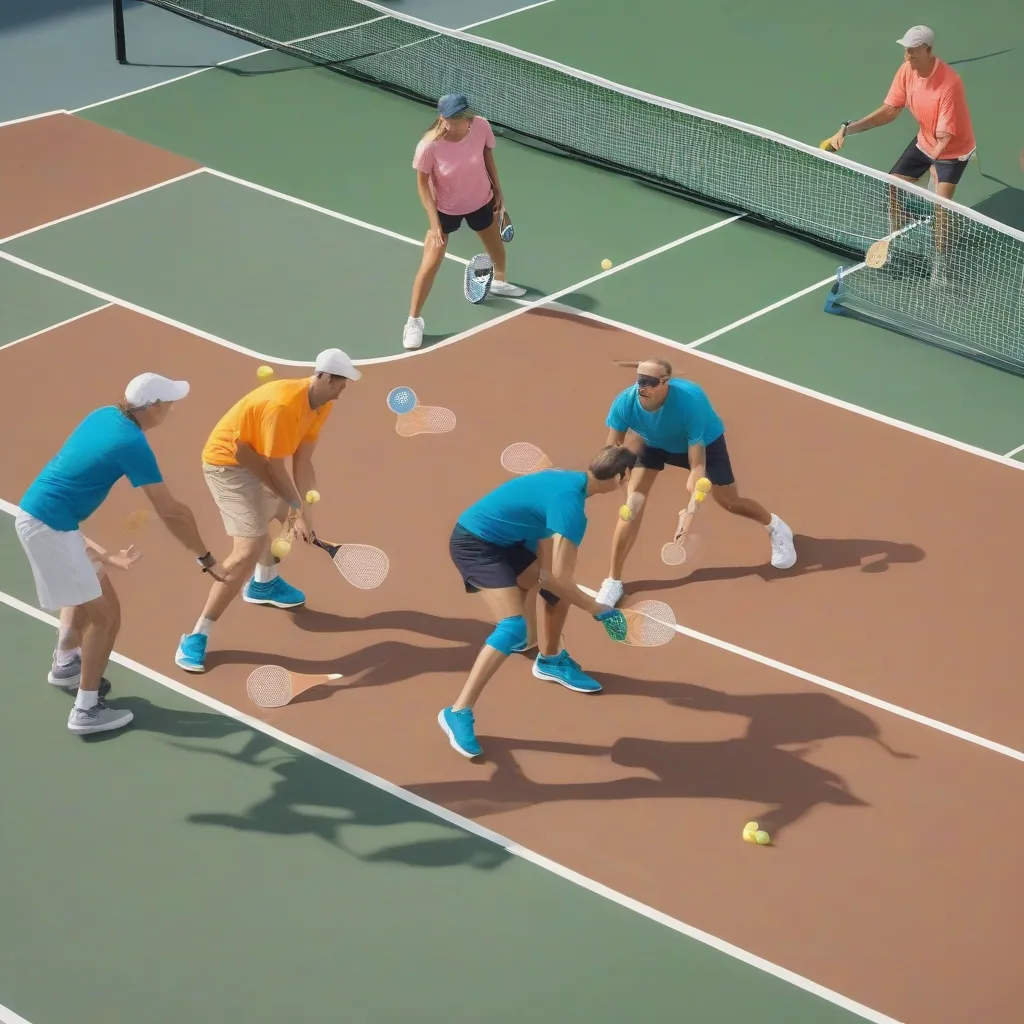Table of Contents
Introduction to Pickleball Beginner Drills
Pickleball is a fun and accessible sport for players of all skill levels. For beginners, mastering the basics is crucial to building a strong foundation. This guide covers the top 10 pickleball beginner drills to help you improve your skills, consistency, and confidence on the court.
Why Drills are Important for Beginners in Pickleball
Practicing drills offers several benefits for beginner pickleball players:
- Skill Development: Drills help you learn and refine essential techniques.
- Consistency: Repetitive practice improves your consistency and accuracy.
- Confidence: Mastering the basics builds confidence in your abilities.
- Game Understanding: Drills help you understand the game’s mechanics and strategies.
Top 10 Pickleball Beginner Drills
 Pickleball Beginner Drills
Pickleball Beginner Drills
1. Dinking Practice
Dinking is a soft shot that lands in the opponent’s non-volley zone. Practice dinking with a partner by standing at the kitchen line and gently hitting the ball back and forth. Focus on control and consistency.
2. Serve and Return
Practice your serve and return with a partner. Aim for specific areas of the service box to improve accuracy. Work on returning serves with controlled, well-placed shots to set up your next move.
3. Forehand and Backhand Groundstrokes
Alternate between forehand and backhand groundstrokes with a partner. Focus on maintaining a steady rhythm and hitting the ball with control and accuracy. This drill helps develop your overall hitting consistency.
4. Volleys at the Net
Stand at the net and practice volleying the ball with a partner. Work on both forehand and backhand volleys, aiming to keep the ball in play with controlled shots. This drill improves your net game and quick reflexes.
5. Cross-Court Dinks
Practice dinking cross-court with a partner. Stand at opposite sides of the court and aim to place the ball softly in the opponent’s non-volley zone. This drill enhances your ability to control the ball and place it accurately.
6. Third Shot Drop
The third shot drop is a soft shot that lands in the opponent’s kitchen, allowing you to move to the net. Practice hitting third shot drops from the baseline, aiming for the non-volley zone. Focus on control and precision.
7. Target Practice
Set up targets on the court using cones or markers. Practice hitting the targets with different types of shots, such as serves, dinks, and volleys. This drill helps improve your shot accuracy and placement.
8. Footwork Drills
Good footwork is essential for effective court coverage. Practice moving quickly and efficiently around the court with footwork drills, such as side shuffles, forward and backward runs, and pivoting exercises.
9. Wall Rally
Use a wall to practice hitting the ball by yourself. Stand a few feet away from the wall and hit the ball continuously, alternating between forehand and backhand shots. This drill helps improve your consistency and hand-eye coordination.
10. King of the Court
Play a game of King of the Court with a group of players. One player starts as the “king” on one side of the net, while challengers try to win a point to take their place. This drill is fun and competitive, helping you practice various shots and strategies in a game-like setting.
Common Mistakes to Avoid in Beginner Drills
Avoid these common mistakes to get the most out of your beginner drills:
1. Skipping Warm-Ups
Always start with a warm-up to prepare your body for exercise. Skipping warm-ups can increase the risk of injuries and reduce the effectiveness of your practice.
2. Overemphasizing Power
Focusing too much on power can lead to errors and inconsistency. Prioritize control and accuracy to improve your overall performance.
3. Ignoring Weaknesses
Identify and work on your weak areas instead of only practicing your strengths. This balanced approach ensures comprehensive skill development.
4. Lack of Consistency
Consistency is key to improvement. Regular practice, even in small increments, is more effective than occasional intense sessions.
5. Skipping Cool-Downs
Cool down after practice to aid recovery and reduce muscle soreness. Incorporate static stretches and gentle movements to help your body relax and recover.
Resources for Further Learning
For more detailed information on pickleball beginner drills, explore these valuable resources:
- Visit the USA Pickleball Association (USAPA) for comprehensive guides and tips.
- Explore instructional videos and articles on Pickleball Central.
- Check out detailed reviews and tutorials on Pickleball Portal.
- Learn from top players and coaches on PickleballMAX.
Conclusion
Practicing beginner drills is essential for building a strong foundation in pickleball. By incorporating these top 10 pickleball beginner drills into your practice routine, you can improve your skills, consistency, and confidence on the court. Use this guide to enhance your training regimen, master the basics, and become a more confident and capable player.
Frequently Asked Questions
- Why are drills important for beginners in pickleball? Drills are important because they help beginners learn and refine essential techniques, improve consistency, build confidence, and understand the game’s mechanics and strategies.
- How can I improve my pickleball skills as a beginner? Improve your skills by practicing regularly, focusing on fundamental techniques, enhancing your footwork, and working on shot placement and consistency.
- What are common mistakes to avoid in beginner drills? Common mistakes include skipping warm-ups, overemphasizing power, ignoring weaknesses, lack of consistency, and skipping cool-downs.
- Where can I find more information on pickleball beginner drills? Visit the USA Pickleball Association, Pickleball Central, Pickleball Portal, and PickleballMAX websites for comprehensive guides and tips.
- How do I create an effective pickleball practice routine as a beginner? Create an effective practice routine by setting specific goals, incorporating a variety of drills, practicing regularly, and balancing intense sessions with rest and recovery.